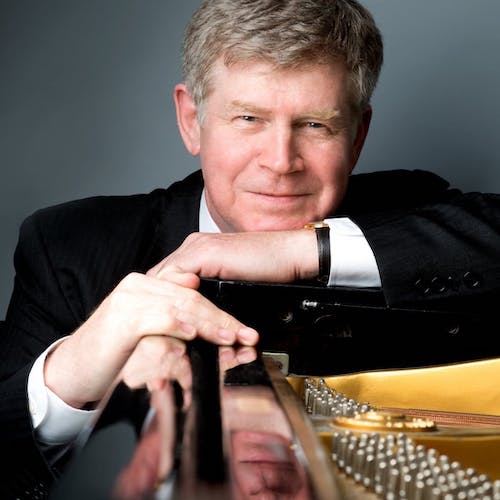Hobson’s mixed recital finds some belated fire at Zankel Hall

Pianist Ian Hobson performed a recital Monday night at Zankel Hall.
It happens so often, someone should do a study.
A recital is a little on the dull side, the performers are playing through their program, not much is going on. But when they get to the encores, they seem almost visibly to exhale, and play with all the brilliance and heart and soul you wish they’d shown earlier.
Something like this happened Monday night with pianist Ian Hobson’s recital in Carnegie’s Zankel Hall. Except Hobson didn’t light up with the encores—he did so with the piece right before the encores: the notoriously finger-twisting, stamina-testing, all-but-unplayable Presto non tanto finale of Chopin’s Sonata No. 3 in B minor, Op. 58.
The pianist, who had been blurring passagework and struggling to shape and drive fast movements all evening, plunged into Chopin’s formidable score and turned it into an edge-of-the-seat conflagration of galloping rhythms, fiery scales, and explosive chords.
Afterward, he returned to the stage and played a settle-down encore, Rachmaninoff’s gentle arrangement of Tchaikovsky’s Lullaby, Op. 16, No. 1, bringing out the interwoven countermelodies with his best voice-leading of the night.
The hall started to empty out, but enough people were staying put and applauding to elicit another encore by Rachmaninoff, his witty, jaw-droppingly virtuosic transcription of the scherzo from Mendelssohn’s A Midsummer Night’s Dream. This was another revelation: The pianist, who hadn’t been able to buy a leggiero all night, spun out one amazingly fast and weightless scale after another. Where was this person before, when there was actual Mendelssohn on the bill?
Ian Hobson holds the title of research professor of Piano at Florida State University, which was the presenter of Monday’s recital, and in the early going this program offered more intellectual stimulation than aesthetic.
Its three pillars were sonatas by Beethoven, Schumann, and Chopin, in which each composer, in his own way, put the new wine of Romanticism in Haydn’s and Mozart’s old bottle. Shorter pieces included the Variations sérieuses of Mendelssohn, inserted in textbook order between the post-Classical Beethoven and the full-blown Romantic Schumann, and (in a slight detour) Brahms-influenced pieces by Dohnányi and Miami-based composer Robert Chumbley, whose Brahmsiana II received its world premiere Monday night.
Beethoven’s Sonata in E minor, Op. 90, is a ruminative piece in just two movements, both in moderate tempo, one wearing a rather severe expression and the other smiling with Schubertian Gemütlichkeit. Here the composer smooths out the old sonata contrasts and peeks over the fence at the magical, undiscovered territory people will eventually call “late Beethoven.”
It’s a delicate, unshowy sonata, and rarely programmed for that reason. Hobson’s matter-of-fact performance didn’t convey much of its two-faced character, or the nuances of feeling within.
Mendelssohn had to call his variations “serious” because most piano variations in his day were empty-headed virtuoso note-spinners on popular tunes from the opera house. This composer, by contrast, began with a Bach-style chorale theme and wrote variations inspired by Beethoven’s great sets, especially the “Diabelli” Variations.
A well-crafted theme-and-variations is, in effect, a cycle of character pieces that thrives on contrasting moods and dramatic pacing. Hobson’s performance didn’t have much of either, and Mendelssohn without leggiero is truly a day without sunshine.
Schumann’s Sonata No. 2 in G minor is famous for its youthful excesses, the first movement marked “As fast as possible” at the beginning, and later “faster,” then “still faster.” As a college professor, Hobson is presumably able to observe youthful excess at close range, and on Monday he actually carried out the composer’s tempo instructions pretty well, if with a lot of blurring. Schumann’s many moods, however—ecstatic, violent, cheerful, anxious, brooding—were mostly beyond the reach of his monochromatic tone.
Tonal limitations also hampered the later movements, especially the dreamy Andantino, but the pianist got around well in the leaping Scherzo and the toccata-style final Rondo.
For the last ten years of his life, right after World War II, Ernő Dohnányi was on the faculty at Florida State. Long before that, in 1903, he composed the Rhapsody in C major, Op. 11, No. 3, modeling it on the vigor and harmonic fluidity of Brahms’s Two Rhapsodies, Op. 79, and adding Hungarian melodies and humor. Hobson gave it a well-paced performance Monday night.
In a program note, composer Chumbley opined that writing for piano developed with piano technology from Beethoven to Chopin to Liszt, with Brahms’s music being the apogee of tonal exploitation of the modern piano. His new piece Brahmsiana II did indeed explore many sonorities associated with this composer, from dark mutterings down low on the keyboard to wide-spaced textures between deep bass and high treble, and from blocky chords to intricate voice-weaving.
Chumbley’s polytonal harmony was more 21st-century than Brahmsian, and it was often hard to tell what the piece was trying to express besides a certain piano sound. Perhaps if Hobson had brought more colors to it, the emotional side would have come through better.
The volatile first movement of the Chopin sonata was well-paced in a flexible tempo, but as in the Schumann its many incidents all sounded like each other. The splendid, ballade-style second theme sang out fairly well, as did the quasi-nocturne that is the sonata’s third movement. Hobson managed some leggiero playing in the bubbly, superfast Scherzo, but this bit of digital magic hardly prepared one for the spectacular event that was the Finale.
One likes to think that we are all as good as our best moments, so let the record show that Ian Hobson gave us some fine ones Monday night, albeit late in the evening.